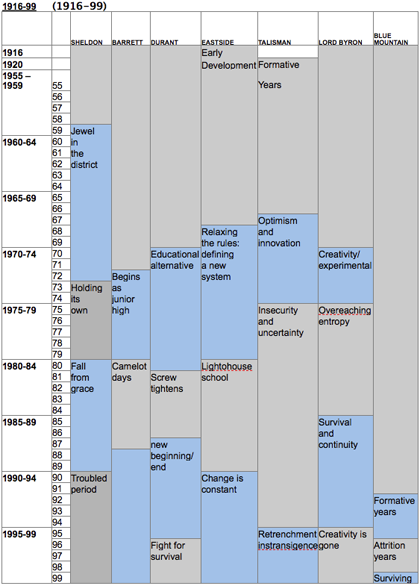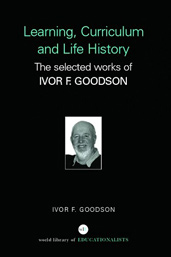Learning, Curriculum and Life Politics: the selected works of Ivor F. Goodson
Long Waves of Educational Reform
The chart [see table 1] indicates that a pattern of conjunctures can be discerned for all schools in the late 1990s, and for five of the schools for the period 1967-79. The exception to the latter conjunctures are Blue Mountain (which was not founded until 1992), and Barrett School (which ran counter to the trend by becoming a ‘Magnet School’ in 1980).
Table 2. 1916-1999: Conjuncture

The features of the 1967 - 79 conjuncture [see table 2] can be generally discerned in all of the case study schools, even though they are very different types of schools with different clienteles and objectives in different districts and countries. It would seem that at this time, there was a shift in the ethos of schooling is part of a generalized economic upswing throughout the western world. Studies in the United Kingdom and Europe, in Australia and New Zealand, point to similar characteristics emerging in schools in this period.
In the Canadian case study schools, a clear link can be made with the changing climate of opinion among educational policy-makers in the economically buoyant period of the mid-60’s. In the United States at this time, Lyndon Johnson was busy laying down the foundations for the ‘Great Society’, with a wide range of inclusive educational policies typified by project Headstart.
In Canada, in June 1968, the Committee on Aims and Objectives of Education in the Schools of Ontario (the Hall-Dennis committee) published its report, recommending wholesale reform of the provincial system to establish ‘a child-centered learning continuum that invites learning by individual discovery and inquiry’ (1968, p. 179). In the opinion of the standard history of 20th Century Ontario schools, Living and Learning was ‘the most radical and bold document ever to originate from the bureaucratic labyrinth of the provincial Department of Education’ (Stamp 1982, p. 217).
Hall-Dennis created an atmosphere conducive to curriculum change at Eastside School. Teachers were taking the freedom implied by Hall-Dennis and trying new curriculum and new teaching methods, although many of them had no direct relationship to the recommendations of the committee. One teacher recalled:
It was a time, when I got there; there was a lot of experimentation going on. Hall-Dennis had just come in. And it was a very interesting situation because I don’t think people really understood what Hall-Dennis was all about. And as a result, everybody was experimenting trying to find out what worked (Interview, 2 May, 1993).
Unusually, this was especially true in academic subjects, where a typical time-intensive project saw one class making a film remake of Easy Rider on the city’s streets (Interview, 2 May, 1993).
